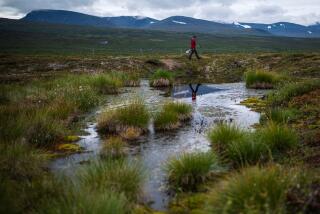Airborne Soot Adds to Arctic Melting, Study Finds
- Share via
Soot pollution from southern Asia appears to be contributing to climate changes at the North Pole, raising atmospheric temperatures and speeding up the melting of snow and sea ice, according to a study by scientists at NASA.
The researchers, who have been using satellite imaging to track the effects of soot, or black carbon emissions, believe they have found a link between the timing of Arctic warming and ice loss and deposits of tiny particles from man-made pollution during the late 20th century.
The findings, which support earlier conclusions, demonstrate that the climate changes affecting the Arctic region are complex and may be a result of traditional pollution as well as global warming from the release of heat-trapping greenhouse gases.
The findings also show that most of the pollution in the Arctic does not come from smokestacks and tailpipes in the developed world, but from industrial emissions in South Asia and forest fires and the burning of other vegetation around the planet.
The study, co-authored by Dorothy Koch of Columbia University and James Hansen of NASA’s Goddard Institute for Space Studies, was published recently in the Journal of Geophysical Research.
“Soot is a particular concern in the Arctic because it can accelerate the melting of the ice and snow,” Koch said in an interview. “The standard knowledge has always been that most of it comes from Northern Europe and Asia. We were surprised to find that much of it comes from further south.”
When soot particles fall on ice, they darken the surface. The seemingly minuscule shift in coloration can make the ice more prone to absorb sunlight instead of reflecting it, and can thus cause it to melt more easily.
Similarly, tiny soot particles can warm the air and have been shown to alter weather patterns and affect the formation of clouds, which collect condensation around tiny airborne particles known as aerosols.
Pollution particles can increase the number of aerosols in clouds, which in some cases have been found to reduce the amount of rain that the clouds release. In other cases, research suggests that the tiny flecks can cause clouds to stay together longer, resulting in more intense precipitation when the clouds finally release their moisture.
Other NASA research into black carbon pollution three years ago suggested that soot emissions may have contributed to flooding in China.
During the 1980s, much of the soot pollution above the Arctic was believed to come from Russia and Europe. Though those emissions have declined, pollution from southern Asia appears to have increased.
About a third of the soot over the Arctic now comes from South Asia, which has the highest industrial soot emissions in the world, says the study, which used computer models and satellite data to track the pollution. Another third comes from the burning of vegetation and natural materials around the world; the rest comes from Russia, Europe and North America.






